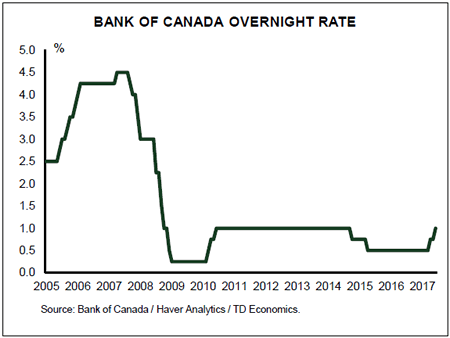U.S. Highlights
- Equity markets continued their winning streak this week. The economic data was generally supportive of the cheerful mood, with the Empire and Philly Fed indices both posting better-than-expected improvements in October.
- Next week’s GDP data is likely to confirm solid growth in Q3, if somewhat dented by Hurricane disruptions. That is consistent with the picture painted by this week’s Beige Book.
- There are plenty of potential policy-related moves afoot for markets to speculate on. A Fed Chair appointment is imminent, and GOP tax reform efforts crossed another milestone this week.
Canadian Highlights
- Manufacturing and retail sales moved in opposite directions in August, with factory shipments up 1.6% while retail sales slid 0.3%. Headline inflation was up by 1.6 y/y in September, (from 1.4% y/y). Core inflation was relatively unchanged.
- The Business Outlook Survey showed that sentiment pulled back in the third quarter, but remains positive, consistent with a solid pace of economic growth.
- OFSI released revised "B-20" guidelines for residential mortgage underwriting at federally regulated financial institutions this week, extending the ‘stress test’ to all borrowers rather than just those requiring mortgage insurance and those with terms of less than five years. This is likely to pour more cold water on an already cooling housing market.
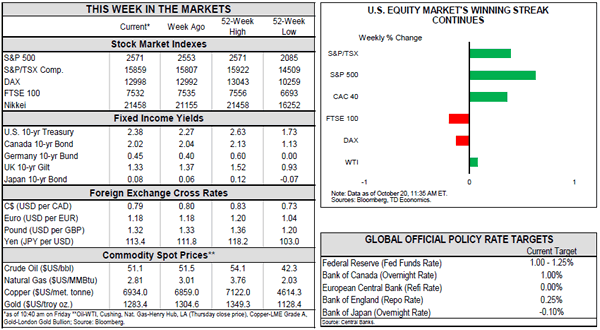
U.S. – Wall Street’s Cheerful Mood Continues
Equity markets continued their winning streak this week, while volatility remains low. Perhaps not surprisingly, businesses and consumers are cheerful too. The latest regional Fed manufacturing surveys – the Empire and the Philly Fed indices – both showed a better-than-expected uptick in October (Chart 1). These readings came after the Michigan Sentiment index, a measure of consumer confidence, reached a new post-recession high last Friday.
Even the one blemish in the economic data this week was pretty small. Housing starts fell further than markets expected in September, but were heavily affected by hurricane disruptions. Permits for single family homes increased, which suggests that the weakness in starts should prove temporary. This notion is further supported by an improvement in homebuilder confidence in October. Conditions in existing home markets also remain tight, further building the case for stronger starts ahead.
The first estimate of real GDP growth for Q3 is released next week. We are tracking growth of around 2 ½%, slightly better than in our recent forecast. That pace will likely be boosted by inventory restocking and net-trade. Growth in final domestic demand is expected to be more modest at 1.6%, reflecting the temporary disruptions from the hurricanes. Domestic demand is expected to rebound 3% in Q4 as rebuilding efforts get underway.
Meanwhile, speculation is rife on who will be the next Fed Chair. Yellen, whose term expires in February, had a meeting at the White house this week. Trump has also met with noted Stanford Professor John Taylor, of the eponymous "Taylor Rule." Also in the running are former Fed governor Kevin Warsh, and current Fed governor, Jerome Powell. Right now online markets show Powell as the odds-on favorite. He is perceived as being least disruptive to markets, while still enabling the President to be seen to put his stamp on the Fed. Taylor and Warsh would represent a bigger change, and are perceived as more hawkish choices, as both likely would have set rates higher than they are now, if they had been Fed Chair.
Many in the GOP have been critical of the Fed, which suggests an outsider like Warsh or Taylor may have a leg up. But, President Trump also has a stated preference for low rates, which may have him lean toward the status quo. Notably, selecting a new Fed Chair would break with 40 years of convention of incoming presidents reappointing Fed Chairs, even if they were appointed by the opposing party. Trump’s choice is likely to be named in two weeks.
Elsewhere on Capitol Hill, Republican’s tax reform efforts passed another milestone this week as the Senate passed its budget resolution. The resolution does not settle the specifics of tax reform, but, it does earmark $1.5 trillion for tax cuts. The work of containing tax cuts to that amount from an estimated price tag of around $2.4 trillion will be done by the tax legislation writing committees in the House and the Senate. While details are scarce, the Senate budget gets back to balance through very steep spending cuts (Chart 2). This could exert a meaningful drag on growth, potentially offsetting any near-term boost from tax reform.
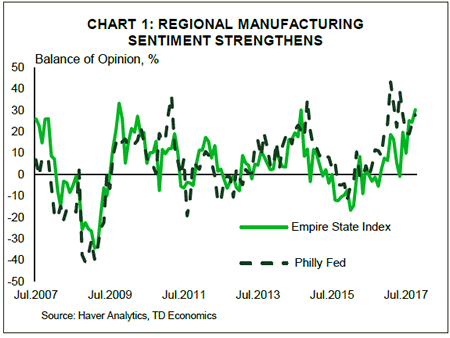
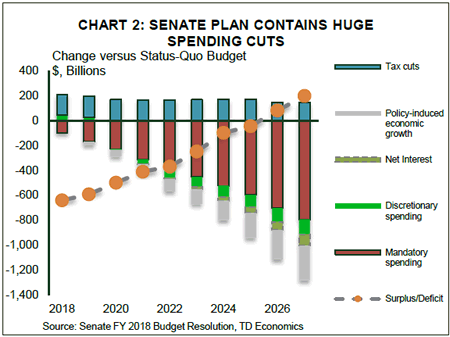
Canada – All About The Data
The economic calendar in Canada was quite full this week, with a slew of data released that will ultimately help shape the Bank of Canada’s ‘data dependent’ decision next week. Manufacturing and retail sales moved in opposite directions in August. Following two months of declines, manufacturing sales rebounded by 1.6%, with volumes up 1.2%. The bounce back was due in large part to a 13% jump in auto output, after plants resumed normal operations following summer shutdowns. Meanwhile, sales excluding autos and parts edged up by only 0.2% during the month.
Retail sales, meanwhile fell 0.3% in August, with volumes down 0.7%. Much of the weakness stemmed from industries typically associated with housing, which is consistent with the slowdown in activity in recent months. Overall, this week’s data still has the Canadian economy on track for growth of close to 2.5% in the third quarter.
Inflation data out this morning showed that prices were up 1.6% (year-on-year) in September, up from 1.4% in August. However, higher gasoline prices were the main driver of the increase, with core inflation little changed during the month.
The Business Outlook Survey (BOS) that was released on Monday is perhaps the most important indicator for the upcoming interest rate decision. The Bank of Canada has put a lot of weight on this survey in recent quarters. The BOS showed that sentiment pulled back in the third quarter – which is not surprising given the strength seen through the first half of the year – but remains broadly positive, consistent with solid growth through the rest of the year. The survey results provide some support for the Bank’s decision to hike interest rates twice this year already, and will help the Bank maintain its tightening bias. That said, the survey, combined with limited price pressures, suggests that there is no urgency to hike rates further.
What’s more, the Office of the Superintendent of Financial Institutions (OSFI) released revised "B-20" guidelines for residential mortgage underwriting at federally regulated financial institutions this week, extending the ‘stress test’ to all borrowers rather than just those requiring mortgage insurance and those with terms of less than five years. We suspect that the rule change will pull forward some demand ahead of the January 1st, 2018 effective date, and slow housing market activity thereafter. Indeed, we estimate that housing demand could fall by 5-10%, while prices could slide by 2-4% in 2018 relative to baseline, as a result of the change.
Given these mortgage rule changes, combined with other regulatory changes in some regional markets such as Ontario, the Bank of Canada will have to be cautious in its tightening approach, so as to ensure a soft landing in the housing market. As such, all eyes will be on the Bank’s Monetary Policy Report that will come alongside its rate decision next Wednesday. At this point, we expect the Bank to remain on the sidelines next week, with the forthcoming communication key in assessing the future path for interest rates.
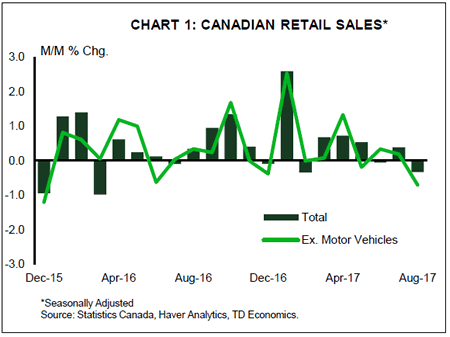
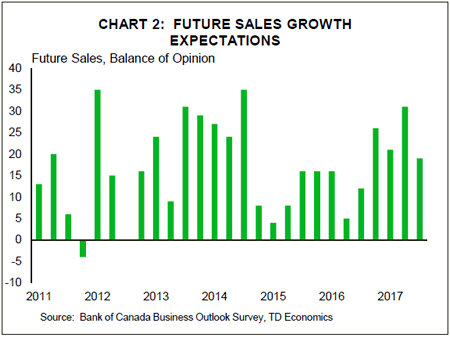
U.S.: Upcoming Key Economic Releases
U.S. Real GDP – Q3
Release Date: October 27, 2017
Previous Result: 3.1%
TD Forecast: 2.5%
Consensus: 2.6%
We expect a 2.5% advance in Q3 GDP, with downside risks amid uncertainty surrounding the hurricanes. The storms’ negative impact is likely to be concentrated in nonresidential structures and homebuilding, while we see a risk for weaker consumer spending as services could take a hit. However, the Fed is likely to look through any data disappointment that could be attributed to the hurricanes.
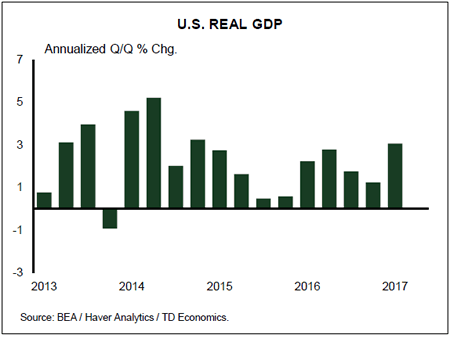
Canada: Upcoming Key Economic Releases
Bank of Canada Interest Rate Decision
Release Date: October 25, 2017
Previous Result: 1.0%
TD Forecast: 1.0%
Consensus: 1.0%
We expect the Bank of Canada to keep policy rates unchanged in October. Market reaction will hinge on key elements of the communique, notably the output gap and characterization of recent data. We look for the output gap to continue to close by "late 2017", underpinned by upward revisions to GDP growth. Upbeat data, from business sentiment and housing to wages and core inflation – also call for the data-dependent central bank to present a more upbeat message than in their latest communications. But in light of Poloz’s defiantly neutral tone of late and uncertainty over potential output and NAFTA, the risk of a major dovish repricing in rate hike expectations is nontrivial in our view.
